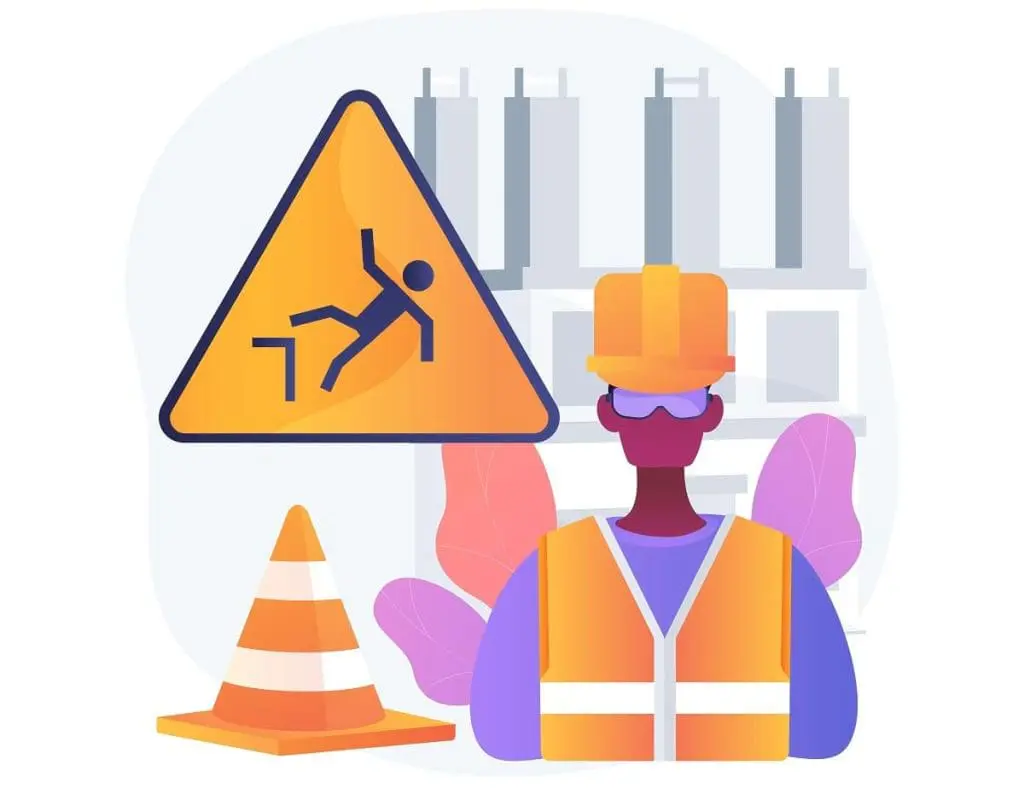Workplace safety examples and their implementation must be a top workplace priority for any employer. Regulatory bodies such as the Occupational Safety and Health Administration (OSHA) not only require your workforce to be protected, but your employees expect it too. According to a recent survey, 75% of workers say they are more likely to stay with a company that prioritizes physical safety, illustrating the impact of practical workplace safety examples.
Despite this, the same study found that more than half of employees are exposed to a safety hazard on the job at least one or two times each week.
In this blog, we explore occupational safety rules and regulations, share tips to help you comply, and shine a light on real-life examples of workplace safety success.
Introduction to Workplace Safety

Workplace injuries and illness are a leading cause of absenteeism, lost productivity, and workers’ compensation claims volume.
The Importance of Occupational Safety
Proactive changes that improve workplace safety can result in significant improvements to your organization’s productivity and financial performance. Consider the statistics from OSHA:
- Companies spend $170 billion each year on costs associated with workplace incidents.
- Workplace safety programs lower injury incidences from anywhere between 9% and 60%.
- Workplace safety programs can reduce injury and illness costs by up to 40%.
Role of Employers and Employees in Ensuring Safety
As an employer, below are some recommended measures to take when designing an efficient workplace safety program:
- Identify hazards in the workplace.
- Develop an accident prevention plan to mitigate risks.
- Educate employees and encourage their involvement in safety protocols.
- Keep appropriate records and create a report when an incident occurs.
- Regularly reassess your safety program to identify areas for improvement.
Workplace Safety Examples
Workplace safety must be practiced regardless of industry or the workplace location, but some workplaces are more high-risk than others.
Let’s look at a few health and safety in the workplace examples and common hazards that employees face:
Safety in the Manufacturing Industry
Risks associated with manufacturing include operating heavy machinery, handling chemicals, hazardous materials, and electric or fire hazards.
According to OSHA, workers who operate and maintain machinery suffer approximately 18,000 amputations, lacerations, crushing injuries, abrasions, and more than 800 deaths per year.
Measures such as machine guarding, noise and hearing protection, respiratory protection, and slip and fall prevention can help reduce risks.
Office Workplace Safety Examples
According to the Bureau of Labor Statistics (BLS), private employers reported 2.6 million non-fatal workplace injuries and illnesses in 2021. The most common office safety hazards include slipping, tripping, and falling; ergonomic injuries; poor lighting and eye strain; indoor air pollution; and fire hazards.
Construction Site Safety Measures
The construction sector is widely known for its high level of danger. Apart from handling bulky machinery and equipment, workers face risks from harmful chemicals and materials and working at great heights.
Statistics reveal that falls, slips, and trips are responsible for 35% of fatalities and 21,400 non-lethal injuries within the industry. Regrettably, the number of fatal accidents in construction has hit a five-year high.
Construction site safety measures include wearing hard hats, safety respirators and masks, reflective gear, protective earmuffs, and more.
Retail and Hospitality Safety Precautions
The retail and hospitality industry exposes employees to a variety of risks including heavy lifting and other ergonomic risk factors, slips and falls, fire and electrical hazards, and more.
These risks have consequences. According to the BLS, retail has among the highest rates of workplace injuries and illnesses, growing from 341,100 cases in 2020 to 404,000 cases in 2021. Meanwhile, approximately one in 1,000 hotel workers are injured on the job each year.
Health and Safety in the Remote Work Environment
Employers have a responsibility for employee health and safety, wherever they work – at home or in a remote office.
Despite the lack of regulatory guidance on managing the health and safety of remote workers, it is wise to implement measures to identify and minimize potential safety risks. These include workplace ergonomics, lighting, HVAC, and other environmental factors that could affect the well-being of remote employees. Additionally, consider offering support services to promote mental and emotional well-being so that remote workers feel supported and valued.
Occupational Safety Rules

As an employer, you must comply with occupational safety rules and standards required by the federal government and your state’s occupational safety and health division.
Regulatory Bodies and Standards
The most widely recognized regulatory agency is OSHA, which establishes safety standards and provides guidance to employers. OSHA also monitors workplace safety incidents and enforces regulations through targeted inspection programs. Visit the OSHA website to search standards by keyword or industry.
Other bodies and standards include the National Institute for Occupational Safety and Health (NIOSH) and state regulatory bodies.
Employee Training and Compliance
Occupational safety rules and regulations require employers to train workers who face hazards on the job.
Explore the resources offered by OSHA and the National Safety Council (NSC). Both provide tools, outreach, and education to help you comply with workplace safety obligations.
Reporting and Accountability
As an employer, you must adhere to workplace safety reporting requirements, including:
- Reporting a workplace fatality to OSHA within eight hours. Severe injuries (work-related hospitalization, amputation, or loss of an eye) must be reported within 24 hours.
- If you employ more than 10 employees, you must keep a record of severe injuries and illnesses and maintain them at your worksite for at least five years.
OSHA may conduct inspections of your workplace without advance notice. However, you can require a compliance officer to obtain an inspection warrant before entering your worksite.
8 Workplace Safety Tips

Below are a few things you can do to create a safer workplace environment.
Maintain a Clean and Organized Workspace
To prevent falls, slips, and trips, remove any clutter or unnecessary items in the workplace. Ensure employees keep their workspaces clean and sanitized.
Use Personal Protective Equipment (PPE)
Remind workers who are exposed to hazardous materials or environments to wear protective equipment, such as goggles, respiratory protection, or a hard hat.
Practice Good Ergonomics
Educate employees on proper posture. From lifting heavy boxes to sitting at a workstation, good ergonomics is the easiest way to avoid aches, pains, and injuries.
Implement Regular Breaks and Stretching
Tired or overworked employees are easily distracted and may not focus on their work, creating a liability. Encourage regular breaks and stretching. Even a quick walk around the block can help workers rest and recharge.
Adhere to Proper Chemical Handling Procedures
Inform employees of the proper procedure for handling hazardous chemicals. Provide safety data sheets, label all containers, and train employees on how to respond to chemical exposure.
Prioritize Fire Safety and Prevention
Make sure fire alarms and suppression systems are installed and working properly, eliminate fire hazards, post escape plans, practice frequent fire drills, and teach employees about fire safety and prevention.
Encourage Reporting of Hazards and Near Misses
Identifying workplace hazards is key to mitigating them. Require that all employees report unsafe conditions promptly and act quickly to remediate risks.
Stay Up-to-Date with Safety Training and Education
Stay current with new standards or procedures and invest in continuing workplace safety training so that everyone knows how to avoid and respond to an incident.
Health and Safety Advice
From removing hazards to reporting unsafe conditions, small steps can make a big difference. Below are four guidelines to keep your workplace safe:
- Implement an effective safety program
- Encourage employee participation
- Conduct regular safety audits and inspections
- Invest in safety education and training
Real-Life Examples of Workplace Safety Success
Workplace safety can have a huge impact on employee morale and productivity, and lessen your liability as an employer – as many exemplary employers have found out.
Companies Excelling in Workplace Safety
Employers that exhibit a dedication to worker safety and health are consistently acknowledged by regulators and NGOs. Check them out below:
- NSC’s “CEOs Who Get It” Recognition Program: Take a look at the latest list of CEOs and organizations that prioritize workplace safety and discover their approaches to ensuring that every worker returns home safely at the end of each shift.
- OSHA Voluntary Protection Program: Recognizes organizations and federal agencies that have implemented effective workplace safety programs.
- OSHA’s small business success stories
Lessons Learned from Successful Workplace Initiatives
A dedication to workplace safety goes beyond adhering to regulatory requirements. As success stories prove, it’s about integrating new technologies such as safety tracking tools, broadening the scope of programs to include employee behavioral health and wellbeing, and bolstering worker engagement by listening to their ideas and concerns.
Prioritizing Workplace Safety Examples and Health in the Workplace

With an effective workplace safety program, which includes the implementation of practical workplace safety examples, you can proactively prevent injury and illness. A safe workplace is not only a moral obligation but also sound business. An effective workplace safety program, with tangible workplace safety examples, can significantly reduce costs related to injury and illness. Prioritizing occupational safety also gives you a recruiting edge, decreases absenteeism, increases productivity, and enhances employee satisfaction.
It’s never too late to start.
Learn how Acuity’s occupational health and workplace safety services can help you maintain a healthy, safe, and productive workforce, employing the best workplace safety examples.
